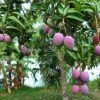Position
Full sun, at least 6 – 8 hours daily. Cannot tolerate cold
Soil
Well-drained loamy slightly acidic soil, add at least one bag of acid compost. Adding half a bag of our Volcanic Rock Dust (R25 per bag) and a bag of Superfrass (R25 per bag) will assist in rapid growth. They also protect the roots from being eaten by insects.
Watering
Regular watering in summer. Sparse watering in colder months.
Mulching
Add a thick layer of pine bark mulch, keeping it about 20 to 30 centimetres away from the tree trunk (any closer may cause excess moisture and damage the trunk). Mulch will retain the moisture in the soil and will prevent weeds from taking over.
Fertilizing
Apply one teaspoon every 4-5 months of our slow-release all-plant fertiliser. The roots will absorb what they need.
Pruning
Prune in winter (dormant season) to remove dead wood and shape the tree. Typically grows to 9 meters tall, but can be pruned to remain compact for smaller gardens.
Train as an open centre (vase shape) for good light penetration and air circulation.
Practice good garden hygiene (remove fallen fruit and leaves.
Pests & Diseases
Black stone mango trees in South Africa are susceptible to a variety of pests and diseases that can impact fruit yield and tree health. Key pests include fruit flies, mango seed weevil, various scale insects, thrips, and mealybugs. Common diseases include anthracnose, powdery mildew, bacterial black spot, mango malformation, and sooty mold. Preferably use preventative measures by spraying with agricultural Neem Oil or Effective Microorganisms (EM Control)
Harvesting
Black stone mango’s ripen from December through to March.






